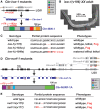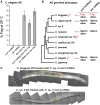Dependence of the sperm/oocyte decision on the nucleosome remodeling factor complex was acquired during recent Caenorhabditis briggsae evolution
- PMID: 24987105
- PMCID: PMC4166919
- DOI: 10.1093/molbev/msu198
Dependence of the sperm/oocyte decision on the nucleosome remodeling factor complex was acquired during recent Caenorhabditis briggsae evolution
Abstract
The major families of chromatin remodelers have been conserved throughout eukaryotic evolution. Because they play broad, pleiotropic roles in gene regulation, it was not known if their functions could change rapidly. Here, we show that major alterations in the use of chromatin remodelers are possible, because the nucleosome remodeling factor (NURF) complex has acquired a unique role in the sperm/oocyte decision of the nematode Caenorhabditis briggsae. First, lowering the activity of C. briggsae NURF-1 or ISW-1, the core components of the NURF complex, causes germ cells to become oocytes rather than sperm. This observation is based on the analysis of weak alleles and null mutations that were induced with TALENs and on RNA interference. Second, qRT-polymerase chain reaction data show that the C. briggsae NURF complex promotes the expression of Cbr-fog-1 and Cbr-fog-3, two genes that control the sperm/oocyte decision. This regulation occurs in the third larval stage and affects the expression of later spermatogenesis genes. Third, double mutants reveal that the NURF complex and the transcription factor TRA-1 act independently on Cbr-fog-1 and Cbr-fog-3. TRA-1 binds both promoters, and computer analyses predict that these binding sites are buried in nucleosomes, so we suggest that the NURF complex alters chromatin structure to allow TRA-1 access to Cbr-fog-1 and Cbr-fog-3. Finally, lowering NURF activity by mutation or RNA interference does not affect this trait in other nematodes, including the sister species C. nigoni, so it must have evolved recently. We conclude that altered chromatin remodeling could play an important role in evolutionary change.
Keywords: Caenorhabditis briggsae; NURF complex; chromatin remodelers; evolution.
© The Author 2014. Published by Oxford University Press on behalf of the Society for Molecular Biology and Evolution.
Figures





Similar articles
-
Sex Determination in Nematode Germ Cells.Sex Dev. 2022;16(5-6):305-322. doi: 10.1159/000520872. Epub 2022 Feb 16. Sex Dev. 2022. PMID: 35172320 Free PMC article. Review.
-
Specification of germ cell fates by FOG-3 has been conserved during nematode evolution.Genetics. 2001 Aug;158(4):1513-25. doi: 10.1093/genetics/158.4.1513. Genetics. 2001. PMID: 11514443 Free PMC article.
-
Evolutionary change within a bipotential switch shaped the sperm/oocyte decision in hermaphroditic nematodes.PLoS Genet. 2013;9(10):e1003850. doi: 10.1371/journal.pgen.1003850. Epub 2013 Oct 3. PLoS Genet. 2013. PMID: 24098152 Free PMC article.
-
Regulation of the sperm-to-oocyte transition in Caenorhabditis briggsae hermaphrodites by the Cbr-met-2 and Cbr-fem-3 genes.Mol Reprod Dev. 2018 Jun;85(6):532-542. doi: 10.1002/mrd.22991. Epub 2018 May 23. Mol Reprod Dev. 2018. PMID: 29693773
-
The nucleosome remodeling factor.FEBS Lett. 2011 Oct 20;585(20):3197-207. doi: 10.1016/j.febslet.2011.09.003. Epub 2011 Sep 9. FEBS Lett. 2011. PMID: 21920360 Free PMC article. Review.
Cited by
-
Genome Editing in C. elegans and Other Nematode Species.Int J Mol Sci. 2016 Feb 26;17(3):295. doi: 10.3390/ijms17030295. Int J Mol Sci. 2016. PMID: 26927083 Free PMC article. Review.
-
Selection on a Subunit of the NURF Chromatin Remodeler Modifies Life History Traits in a Domesticated Strain of Caenorhabditis elegans.PLoS Genet. 2016 Jul 28;12(7):e1006219. doi: 10.1371/journal.pgen.1006219. eCollection 2016 Jul. PLoS Genet. 2016. PMID: 27467070 Free PMC article.
-
Sex Determination in Nematode Germ Cells.Sex Dev. 2022;16(5-6):305-322. doi: 10.1159/000520872. Epub 2022 Feb 16. Sex Dev. 2022. PMID: 35172320 Free PMC article. Review.
-
Full-genome evolutionary histories of selfing, splitting, and selection in Caenorhabditis.Genome Res. 2015 May;25(5):667-78. doi: 10.1101/gr.187237.114. Epub 2015 Mar 17. Genome Res. 2015. PMID: 25783854 Free PMC article.
-
From "the Worm" to "the Worms" and Back Again: The Evolutionary Developmental Biology of Nematodes.Genetics. 2018 Oct;210(2):397-433. doi: 10.1534/genetics.118.300243. Genetics. 2018. PMID: 30287515 Free PMC article. Review.
References
-
- Andersen EC, Lu X, Horvitz HR. C. elegans ISWI and NURF301 antagonize an Rb-like pathway in the determination of multiple cell fates. Development. 2006;133:2695–2704. - PubMed
-
- Arduengo PM, Appleberry OK, Chuang P, L’Hernault SW. The presenilin protein family member SPE-4 localizes to an ER/Golgi derived organelle and is required for proper cytoplasmic partitioning during Caenorhabditis elegans spermatogenesis. J Cell Sci. 1998;111:3645–3654. - PubMed
-
- Baldi C, Cho S, Ellis RE. Mutations in two independent pathways are sufficient to create hermaphroditic nematodes. Science. 2009;326:1002–1005. - PubMed
Publication types
MeSH terms
Substances
Grants and funding
LinkOut - more resources
Full Text Sources
Other Literature Sources
Miscellaneous

